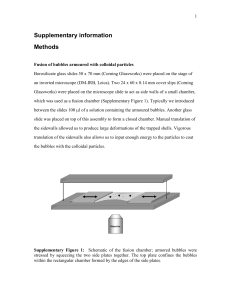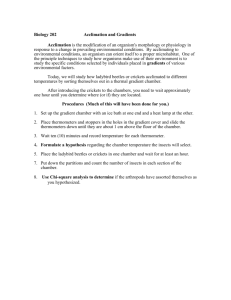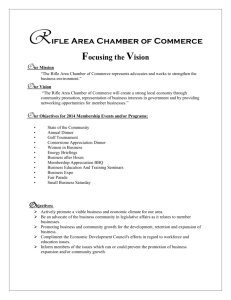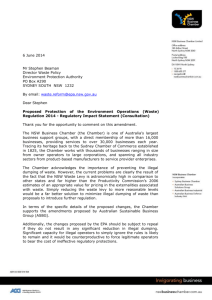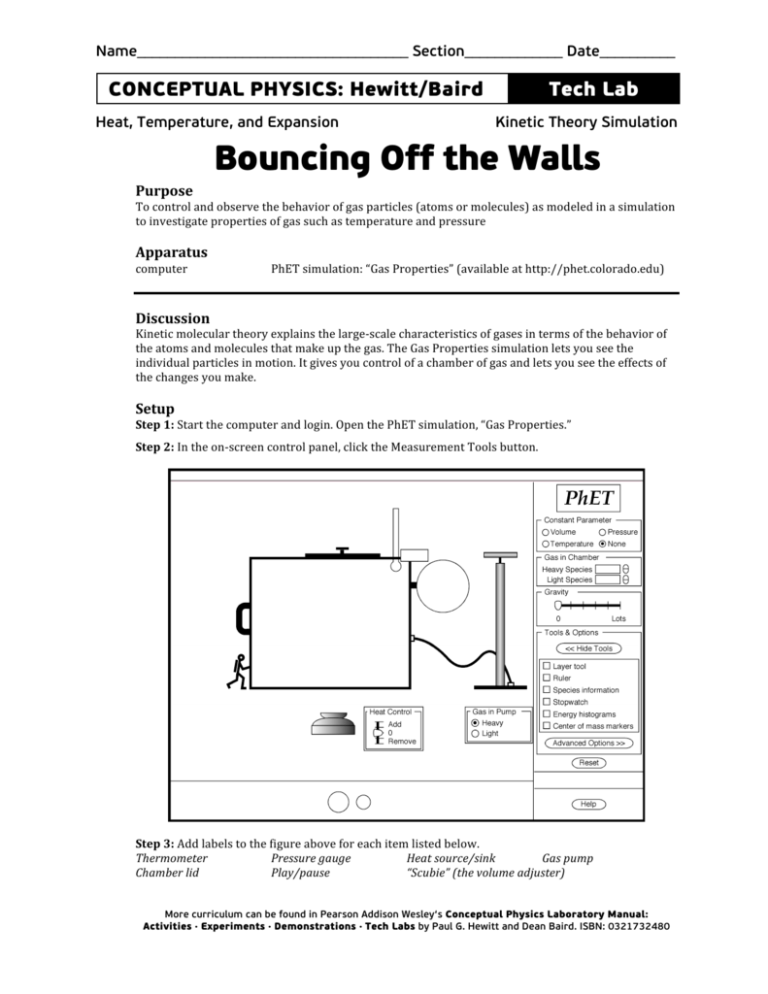
Name____________________________________ Section_____________ Date__________
CONCEPTUAL PHYSICS: Hewitt/Baird
Heat, Temperature, and Expansion
Tech Lab
Kinetic Theory Simulation
Bouncing Off the Walls
Purpose
To
control
and
observe
the
behavior
of
gas
particles
(atoms
or
molecules)
as
modeled
in
a
simulation
to
investigate
properties
of
gas
such
as
temperature
and
pressure
Apparatus
computer
PhET
simulation:
“Gas
Properties”
(available
at
http://phet.colorado.edu)
Discussion
Kinetic
molecular
theory
explains
the
large‐scale
characteristics
of
gases
in
terms
of
the
behavior
of
the
atoms
and
molecules
that
make
up
the
gas.
The
Gas
Properties
simulation
lets
you
see
the
individual
particles
in
motion.
It
gives
you
control
of
a
chamber
of
gas
and
lets
you
see
the
effects
of
the
changes
you
make.
Setup
Step
1:
Start
the
computer
and
login.
Open
the
PhET
simulation,
“Gas
Properties.”
Step
2:
In
the
on‐screen
control
panel,
click
the
Measurement
Tools
button.
Step
3:
Add
labels
to
the
figure
above
for
each
item
listed
below.
Thermometer
Pressure
gauge
Heat
source/sink
Gas
pump
Chamber
lid
Play/pause
“Scubie”
(the
volume
adjuster)
More curriculum can be found in Pearson Addison Wesley‘s Conceptual Physics Laboratory Manual:
Activities · Experiments · Demonstrations · Tech Labs by Paul G. Hewitt and Dean Baird. ISBN: 0321732480
Procedure
PART
A:
SIMULATION
MECHANICS
Remember
that
any
time
you
need
to,
you
can
use
the
on­screen
reset
button
to
return
to
the
initial
setup.
Step
1:
Determine
two
distinct
methods
by
which
you
can
add
particles
to
the
chamber.
a.
Method
1:
Use
the
pump.
How
do
you
manipulate
the
pump
handle
to
get
the
greatest
number
of
particles
into
the
chamber
in
one
stroke?
b.
Describe
Method
2:
How
can
you
precisely
control
the
number
of
particles
injected
into
the
chamber?
(Method
2
does
not
involve
direct
use
of
the
pump.)
Step
2:
How
can
you
release
particles
from
the
chamber
(without
breaking
the
chamber)?
a.
Method
1:
b.
Method
2
(completely
different
from
Method
1):
Step
3:
How
can
you
add
heat
to
the
gas?
How
does
the
simulation
illustrate
this?
Step
4:
How
can
you
remove
heat
from
the
gas?
How
does
the
simulation
illustrate
this?
Step
5:
How
can
you
compress
the
gas
(decrease
its
volume)?
Step
6:
How
can
you
expand
the
gas
(increase
its
volume)?
More curriculum can be found in Pearson Addison Wesley‘s Conceptual Physics Laboratory Manual:
Activities · Experiments · Demonstrations · Tech Labs by Paul G. Hewitt and Dean Baird. ISBN: 0321732480
PART
B:
THE
NATURE
OF
THE
IDEAL
GAS
LAW
Step
1:
What
happens
to
the
pressure
in
the
chamber
if
you
heat
the
gas?
Step
2:
What
happens
to
the
temperature
in
the
chamber
if
you
compress
the
gas?
Step
3:
Locate
the
“Constant
Parameter”
section
of
the
on‐screen
control
panel.
Lock
the
temperature.
Use
“Scubie”
to
slowly
compress
the
gas.
What
happens
to
temperature,
and
what
action
is
taken
(by
the
simulation)
to
maintain
constant
temperature?
Step
4:
Lock
the
pressure.
(Doing
so
releases
the
lock
on
temperature.)
Add
heat.
What
happens
to
pressure,
and
what
action
is
taken
(by
the
simulation)
to
maintain
constant
pressure?
PART
C:
ALL
SPECIES
GREAT
AND
SMALL
Create
a
chamber
in
which
there
is
a
mix
of
50
light
and
50
heavy
gas
particles.
In
the
on‐screen
control
panel,
activate
“Species
Information.”
Step
1:
Consider
the
species
information
and
the
meaning
of
temperature.
a.
Which
species—if
either—has
the
greater
average
speed?
b.
Does
the
temperature
in
the
chamber
reflect
the
average
speed,
momentum,
potential
energy,
or
kinetic
energy
of
the
particles?
And
how
does
this
explain
your
finding
in
Step
1.
a.?
Step
2:
Reset
the
chamber
to
have
about
100
heavy
particles.
The
temperature
should
be
300
K.
Click
the
on‐screen
button
to
activate
the
“Center
of
mass
markers.”
a.
Consider
the
statement,
“The
average
speed
of
air
molecules
in
a
room
may
be
over
1000
mph
(400
m/s)
while
their
average
velocity
is
approximately
zero.”
The
particles
in
the
simulation’s
chamber
are
modeling
the
air
molecules
in
a
room.
Cite
evidence
from
the
simulation
to
confirm
or
reject
the
quoted
statement.
More curriculum can be found in Pearson Addison Wesley‘s Conceptual Physics Laboratory Manual:
Activities · Experiments · Demonstrations · Tech Labs by Paul G. Hewitt and Dean Baird. ISBN: 0321732480
b.
What
is
the
name
of
the
condition
when
the
average
velocity
of
atmospheric
molecules
around
you
is
not
zero?
(Hint:
It’s
a
common
four‐letter
word
starting
with
the
letter
“W.”)
Going
Further
1.
Under
what
specific
condition
will
the
lid
be
blown
off
the
chamber?
Is
it
possible
to
blow
the
lid
with
just
one
particle
in
the
chamber?
2.
Is
it
possible
to
achieve
a
six‐figure
temperature?
If
so,
how?
If
not,
what’s
the
highest
temperature
you
could
achieve?
3.
As
of
2010,
low‐temperature
physicists
have
not
been
able
to
cool
anything
to
a
temperature
of
absolute
zero
(0
K).
a.
Cool
a
simulated
50/50
sample
(50
light
and
50
heavy
particles)
gas
sample
to
absolute
zero.
b.
When
the
temperature
hits
absolute
zero,
are
the
particles
shown
to
be
at
rest?
4.
Use
Scubie
and
the
ice
(Heat
Control:
Remove)
to
compress
and
cool
a
50/50
sample
to
the
smallest
volume
possible
and
to
absolute
zero.
Now
use
Scubie
to
rapidly
expand
the
volume
of
the
chamber
all
the
way
out.
Describe
what
happens.
And
which
species
wins
the
race
to
the
far
side
of
the
chamber
(where
Scubie
is)?
More curriculum can be found in Pearson Addison Wesley‘s Conceptual Physics Laboratory Manual:
Activities · Experiments · Demonstrations · Tech Labs by Paul G. Hewitt and Dean Baird. ISBN: 0321732480




